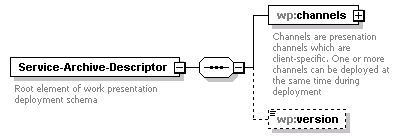| diagram |  |
||
| namespace | http://service.archive.wp.n2.tibco.com | ||
| properties |
|
||
| children | wp:channels wp:version | ||
| annotation |
|
||
| source | <xs:element name="Service-Archive-Descriptor"> <xs:annotation> <xs:documentation>Root element of work presentation deployment schema</xs:documentation> </xs:annotation> <xs:complexType> <xs:sequence> <xs:element name="channels"> <xs:annotation> <xs:documentation>Channels are presenation channels which are client-specific. One or more channels can be deployed at the same time during deployment</xs:documentation> </xs:annotation> <xs:complexType> <xs:sequence> <xs:element name="channel" maxOccurs="unbounded"> <xs:annotation> <xs:documentation>Channel is a presentation channel.At least one channel needs to be specified during deployment.It is possible to just deploy the channel without deploying the assosciate resources or can be a full fledged channel deployment with associated work model type and its resources</xs:documentation> </xs:annotation> <xs:complexType> <xs:sequence> <xs:element name="description" type="xs:string" nillable="true" minOccurs="0"> <xs:annotation> <xs:documentation>Description of the channel that is getting deployed. </xs:documentation> </xs:annotation> </xs:element> <xs:element name="target-channel-type" type="ct:ChannelType"> <xs:annotation> <xs:documentation>Target channel type indicates the client type of channel for viewing the presentation. EMAIL channel is a channel type which might be capable of displaying JSP/Forms/MS-Word type of presentations. </xs:documentation> </xs:annotation> </xs:element> <xs:element name="presentation-channel-type" type="ct:PresentationType"> <xs:annotation> <xs:documentation>presentation type specifies the rendering engine type for the presentation.It can be something like JSP,GI,RCP..etc </xs:documentation> </xs:annotation> </xs:element> <xs:element name="implementation-type" type="ct:ImplementationType"> <xs:annotation> <xs:documentation>Implementation type specifies the fulfillment type of the presentation.This fulfillment type can be a server push/pull </xs:documentation> </xs:annotation> </xs:element> <xs:element name="work-type" minOccurs="0" maxOccurs="unbounded"> <xs:annotation> <xs:documentation>WorkModel type is the work type/work model type defined in BRM.It is assumed that in runtime that work types/ work model types are already deployed and activated before the work presentation request is made.Same work model type can be associated to different presentation forms based on the channel specified. </xs:documentation> </xs:annotation> <xs:complexType> <xs:sequence> <xs:element name="extended-properties" type="wp:extendedPropertiesType" nillable="true" minOccurs="0"> <xs:annotation> <xs:documentation> It is a provision to add custom properties to the work model type which can be interpreted by the Work Presenation Deployment Analyser </xs:documentation> </xs:annotation> </xs:element> <xs:choice> <xs:element name="form" type="wp:formType"> <xs:annotation> <xs:documentation> Form indicates the presentation resource that needs to be displayed for this particular work type request </xs:documentation> </xs:annotation> </xs:element> <xs:element name="page-flow" type="wp:pageFlowType" nillable="false"/> <xs:element name="extension-config" type="wp:channelExtentionType"/> <xs:element name="page-flow-ref" type="wp:pageFlowRefType"/> </xs:choice> </xs:sequence> <xs:attribute name="guid" type="xs:string" use="required"/> <xs:attribute name="name" type="xs:string" use="optional"/> <xs:attribute name="version" type="xs:string" use="optional"/> </xs:complexType> </xs:element> <xs:element name="domain" type="xs:string" minOccurs="0"/> <xs:element name="extended-properties" type="wp:extendedPropertiesType" nillable="true" minOccurs="0"> <xs:annotation> <xs:documentation>It is a provision to add custom properties to the work model type which can be interpreted by the Work Presenation Deployment Analyser. </xs:documentation> </xs:annotation> </xs:element> <xs:element name="extension-config" type="wp:channelExtentionType" nillable="true" minOccurs="0"> <xs:annotation> <xs:documentation>Defines extended channel information, for example, Email Channel, or for a channel not yet implemented in WP. </xs:documentation> </xs:annotation> </xs:element> <xs:element name="business-service" type="wp:businessServiceType" minOccurs="0" maxOccurs="unbounded"> <xs:annotation> <xs:documentation>Defines pageflow business service form related resources. </xs:documentation> </xs:annotation> </xs:element> <xs:element name="page-flow" type="wp:pageFlowType" minOccurs="0" maxOccurs="unbounded"/> </xs:sequence> <xs:attribute name="version" type="xs:string" use="optional"/> <xs:attribute name="channelId" type="xs:string" use="required"/> <xs:attribute name="name" type="xs:string" use="optional"/> <xs:attribute name="defaultChannel" type="xs:boolean"> <xs:annotation> <xs:documentation>Is this a default channel for the target channel type. Note there should be only one default channel per channel type.</xs:documentation> </xs:annotation> </xs:attribute> </xs:complexType> </xs:element> </xs:sequence> </xs:complexType> </xs:element> <xs:element name="version" minOccurs="0"/> </xs:sequence> </xs:complexType> </xs:element> |
WSDL documentation generated by XMLSpy WSDL Editor http://www.altova.com/xmlspy